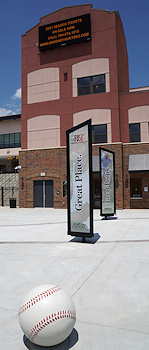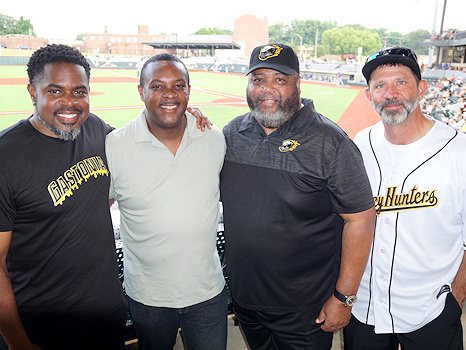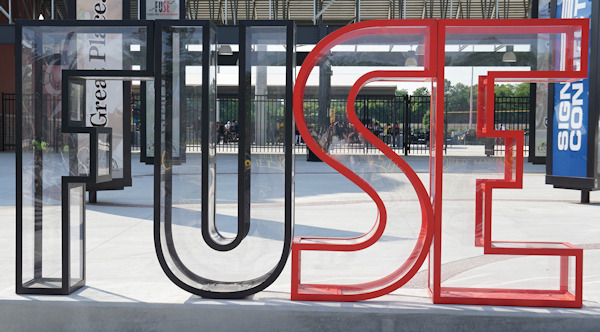
Article and all photos (except as noted) by Joe Mock, BaseballParks.com
All rights reserved
GASTONIA, North Carolina For the past two decades, the city of Gastonia has been planning ambitious rehabilitations of specific neighborhoods that need some TLC. One area is called Loray, after the Loray textile mill that closed in the 1990s. Financing was established to rehab abandoned mill homes. Soon apartments sprang up. The mill building itself is now being remodeled so it can be used for events such as weddings. It also houses the African American Museum of History & Culture.
| Ballpark Stats |
 |
| Team: Gastonia Honey Hunters of the indy Atlantic League |
| First game: May 27, 2021, a 10-4 loss to Lancaster |
| Capacity: 5,000 |
| Dimensions: LF – 315; LCF – 361; CF – 400; RCF – 367; RF – 325 |
| Architect: Pendulum — Jonathan Cole, Principal |
| Construction: Rodgers Builders |
| Price: $28.8 million |
| Home dugout: 3B side |
| Field points: Northeast |
| Playing surface: Astroturf |
| Naming rights: regional healthcare firm CaroMont Health, for 10 years |
| Ticket info: gohoneyhunters.com/tickets/ |
| Betcha didn’t know: In addition to the playing surface being artificial, the infield, warning tracks and even the pitchers mound are artificial, too. |
In 2001, the 35-block area was listed by the National Register of Historic Places.
Between the Loray part of town and Gastonia’s downtown was another area in desperate need of a make-over. Here the city envisioned a new venue for entertainment and sports, with the land around it being available for private developers to create condos and apartments – and maybe a brew pub, restaurants or other retail outlets.
The city decided to designate this 16-acre sector as FUSE – the Franklin Urban Sports and Entertainment District. Franklin Boulevard, you see, runs directly through this neighborhood. Until recently, the sports-and-entertainment facility being constructed at the area’s core was going to be called simply FUSE Ballpark. Then the week before the facility’s grand opening, a corporate naming sponsor was announced. Today the sparkling new venue is called CaroMont Health Park, after a regional healthcare provider.
Kristy Crisp, a 20-year employee of the city and today its Director of Economic Development, says that the stadium’s site was a Sears store, vacant for the past 30 years.
“It was really an eyesore,” she says. “To remove that and replace it with this is a huge transition. It reflects what Gastonia is going through with all of the investment in development here.
“As a lifelong resident here, I’d say it’s perfect.”
THE GUTS OF A GUN FIGHTER
When you meet 49-year-old Brandon Bellamy, you can sense at once that he is an entrepreneur – and a good one. His communication skills are obvious, and his ability to articulate his vision certainly inspires the listener to action.
He’s the sole owner of a firm called The Velocity Company – which fits, because he operates at full speed at all times. Velocity is a Maryland company involved in commercial development. He is especially interested in investing in what he calls “under-invested communities.”
The FUSE area of Gastonia certainly caught his eye. At the time, Bellamy was working for Dennis Crawford in Prince Georges County, Maryland. Crawford was as much mentor as boss to Bellamy. “He told me about this opportunity in Gastonia,” Bellamy tells us. “I saw that Gastonia is sort of like the stepchild of Charlotte, but the people here have grit and determination. And they look to the future.”
| Sims Legion Park |
 |
| Gastonia’s longtime home for baseball is Sims Legion Park. It hosted a team in the South Atlantic League 1977-1992 and a Coastal Plains League squad 2002-2020. |
After meeting with the city’s mayor and city council, he was impressed. “They have the guts of a gun fighter. They had committed the bonds to build the FUSE stadium, but they didn’t have a team.”
He saw the parallels with Kannapolis, about an hour to the east. There was tremendous desire by city leaders for mixed-use development at the city’s core. They already had a team, so they needed a ballpark. Gastonia, though, had committed to a ballpark, but it was a tenant to play there that they lacked. The Atlantic League expressed interest in coming here, but there were no potential owners to make it happen.
Bellamy had never contemplated owning a sports team, and didn’t realize that if he bought a baseball franchise, he’d be the first Black majority owner in the sport. He just wanted to “investigate the baseball business. I could see that there was a lot of gasoline. We just needed the match.”
Isn’t that what a FUSE is for?
  |
| CaroMont Health Park projects a striking image at its southwest entryway. The other photo shows (from left) Honey Hunters owner Brandon Bellamy, architect Jonathan Cole, Gastonia Mayor Walker Reid and City Manager Michael Peoples. |
Bellamy says his development goal is to “build things to make communities come together.” And when he looked at the plans for the FUSE stadium, he saw a facility that could bring people together in ways seldom possible in a city like Gastonia. Baseball. Football. Soccer. Lacrosse. Concerts. Banquets. Weddings. There’s room for all these to happen.
He adds that “The city had the good sense to bring on Pendulum to design it. Jonathan (Cole, Pendulum’s principal) created a masterpiece here. It’s very intelligently designed.”
So Bellamy spearheaded the acquisition of an expansion franchise in the independent Atlantic League – a league whose teams now have extra value since Major League Baseball started considering the eight-team circuit a “partner league.” They act as MLB’s laboratory for rule changes before they bring them into big-league play.
“Honey Hunters” won a name-the-team contest. While the logo shows a hungry honey badger on the prowl, the name also pays homage to a prominent Black landowner in the late 19th Century named Ransom Hunter. He’s believed to be the first freed slave in Gaston County. Bellamy met with five generations of Hunter’s descendants prior to the stadium’s dedication.

HOPE, OPPORTUNITY, INSPIRATION – AND MAGIC
Now that the Honey Hunters are playing baseball at CaroMont Health Park, Bellamy can see the relevance and usefulness of the facility. “It is a physical representation of the things I believe in, which are hope, opportunity and inspiration. That’s how I built my company, and that’s what I see here. Hope is what pulls you forward. It gives people a sense that the future can be better. This should be a catalyst for even more businesses, more jobs and more taxes for the city.”
The fact that an investment by a Black entrepreneur in a city with Black leadership with a ballpark designed by a Black architect didn’t go unnoticed. One interested party was NBA Hall of Famer Earvin “Magic” Johnson, minority owner of the Los Angeles Dodgers and majority owner of food-service operator SodexoMagic. The latter joined forces with national vendor Centerplate and the Honey Hunters to handle concessions and premium dining at CaroMont Health Park.
 SodexoMagic, with 6,500 employees across the country, bases its business model on the three “pillars” of food, wellness and community. They are particularly committed to underserved populations and make it a priority to purchase goods from minority-owned businesses.
SodexoMagic, with 6,500 employees across the country, bases its business model on the three “pillars” of food, wellness and community. They are particularly committed to underserved populations and make it a priority to purchase goods from minority-owned businesses.
Johnson came to Gastonia for Opening Night on May 27 (see photo, where he and Bellamy share a laugh. Photo by Michael Maxwell, courtesy of the Honey Hunters). During pregame ceremonies, he told the crowd, “When I think of what Brandon has been able to do with this incredible stadium, I had to fly here from LA to see it myself.” He also thanked the parents in the crowd for bringing their youngsters, “so they can grow up and dream that they can do something like this, just like Brandon has been able to do.”
“We’re all for Brandon’s commitment to deliver family fun and affordable prices here,” says Bobby Dichiaro, Regional VP for Centerplate. “We want to see folks come back to the ballpark over and over, and not have to take out a loan to pay for concessions.” He adds that his favorite food item at the park is the pulled pork sandwich with Sun Drop BBQ sauce.
Speaking of Sun Drop, this is the rare park that serves neither Coke nor Pepsi. The soft drinks are Sun Drop, Cheerwine and RC Cola.
A LOT OF BALLPARK
A couple of hours before the first game was played here on May 23rd – an exhibition against fellow Atlantic League member High Point – I encountered a fellow who said he was there from out of town to work food service. As we chatted, he noted that I must know some things about ballparks, so he asked me, “Is this a Triple-A park?” I told him it wasn’t. “Then it must be Double-A.” Nope. And not Single-A either. I then told him it was for an independent-league team.
His eyes were wide as he looked around. He finally said, “This is a lot of ballpark for that, with all of the different kinds of seats, premium areas, and huge club upstairs.”
It is indeed a lot of ballpark for indy ball. And it’s a lot for a city of 77,000. And it’s a shocking amount of ballpark for the construction price of only $28.8 million.
Architect Cole has broken the code for creating 5,000-seat ballparks for half the budget of other such facilities. He did it in Utica, Michigan at Jimmy John’s Field, home of all four teams in the United Shore Professional Baseball League. “What I did there, I perfected here,” he says.
 No argument there.
No argument there.
There are six covered “cabana” areas behind third base, an area filled with rocking chairs on field level down the third base line, covered pavilions near both foul poles and a concert- or banquet-ready lounge that can hold 300 people on the upper level (see photo). Plus there’s a practically indestructible Astroturf playing surface (including the mound and warning tracks) that can take a beating no matter what sport or event is happening on top of it.
And the drainage system under the artificial turf makes a tarp unnecessary.
“I like to push the envelope in getting people close to home plate,” Cole explains. “It’s really important to me. That’s where the intimacy is.”
He concedes there’s a lot of foul territory, but it’s a trade-off so a football field will fit.
Always with an eye toward the future, Cole adds “We’re looking ahead to Phase 1 and Phase 2. Plus I’ve not worked with a better City staff than here in Gastonia.”
A sellout crowd greeted the Honey Hunters on Opening Night. “I’m delighted with the level of support here,” says David Martin, the team’s Chief Operating Operator. “And I’m amazed at the level of baseball interest. The sky’s the limit.”
Gastonia resident Kevin Mitchell likes what he sees in the team and ballpark. “When I moved here in 2004, it was just a little, quiet town. Now we’re up and coming and it’s wonderful. It’s good for the community.”
As Bellamy says, “If you draw inspiration from what we’re doing, you’re a Honey Hunter.”
A shorter version of this article originally appeared in USA TODAY Sports Weekly. It’s used here by permission.